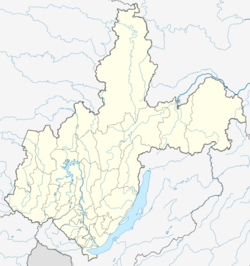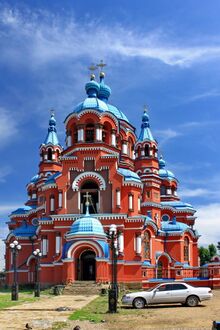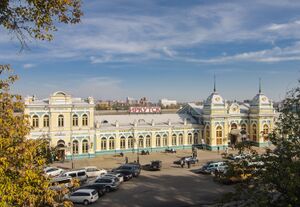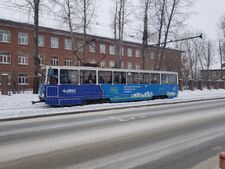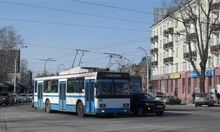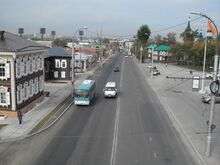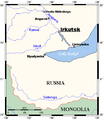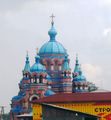إركوتسك
{{ safesubst:#invoke:Unsubst||date=__DATE__|$B=
Irkutsk
Иркутск | |
|---|---|
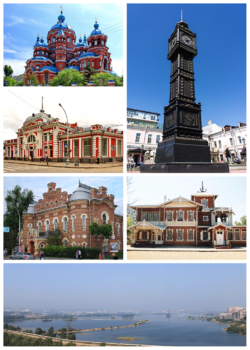 مع عقارب الساعة، من أعلى اليمين: برج الساعة، معرض الصور، پانوراما إركوتسك من السد، متحف التراث المحلي، سينما Khudozhestvenny ، كنيسة كازان. | |
| النشيد: none | |
| الإحداثيات: 52°17′N 104°17′E / 52.283°N 104.283°E | |
| البلد | روسيا |
| الكيان الاتحادي | Irkutsk Oblast[2] |
| Founded | 1661[3] |
| الحكومة | |
| • الكيان | Duma |
| • Mayor[4] | Dmitri Berdnikov[4] |
| المساحة | |
| • الإجمالي | 277 كم² (107 ميل²) |
| المنسوب | 440 m (1٬440 ft) |
| التعداد | |
| • الإجمالي | 587٬891 |
| • الترتيب | 24th in 2010 |
| • الكثافة | 2٬100/km2 (5٬500/sq mi) |
| • Subordinated to | City of Irkutsk[2][1] |
| • Capital of | Irkutsk Oblast[2], Irkutsky District[2] |
| • Urban okrug | Irkutsk Urban Okrug[7] |
| • Capital of | Irkutsk Urban Okrug[7], Irkutsky Municipal District[8] |
| منطقة التوقيت | UTC+ ([9]) |
| Postal code(s)[10] | 664xxx |
| Dialing code(s) | +7 3952[11] |
| OKTMO ID | 25701000001 |
| City Day | First Saturday of June |
| الموقع الإلكتروني | [[1] web |
إركوتسك (روسية: Ирку́тск؛ بالBuryat: Эрхүү؛ إنگليزية: Irkutsk) هي أحد أكبر المدن في سيبريا والمركز الإداري لاوبلاست إركوتسك، تقع على بعد 5٬185 كيلومتر (3٬222 ميل) بالقطار من موسكو. التعداد: 593٬604 (تعداد 2002);[12] 622٬301 (تعداد 1989).[13]
إرْكُتِسْك مدينة روسية، عدد سكانها 592,400 نسمة. وهي مركز للصناعة والنقل والثقافة في روسيا. وتقع المدينة على ضفة نهر أنگارا في سيبريا.
وتشمل أنشطة إرْكُتِسْك الاقتصادية، إنتاج الملابس و مواد التشييد ومنتجات الطعام، والأخشاب. وفيها جامعة و عدد من المعاهد المتخصصة في التعليم العالي بما في ذلك سبعة معاهد أكادمية
وقد أسست إرْكُتِسْك في أواسط القرن السابع عشر الميلادي. و كانت بمثابة مخفر متقدم، و مركز شتوي لصيادي الحيوانات ذات الفراء و للتجار. وصلت سكك حديد سيبريا إلى إرْكُتِسْك عام 1898م وأدت إلى حفز نموها.
أصل الاسم
Irkutsk was named after the Irkut River. Its name was derived from the Buryat word for "spinning," and was used as an ethnonym among local tribes, who were known as Yrkhu, Irkit, Irgit, and Irgyt. The city was formerly known as Yandashsky, named after the local Tuvan chief Yandasha Gorogi.[14]
The old spelling of the city's name was «Иркуцкъ». Before the revolution, the city was called "East Paris", "Siberian Petersburg", "Siberian Athens".
التاريخ
In 1652, Ivan Pokhabov built a zimovye (winter quarters) near the site of Irkutsk for gold trading and for collecting fur taxes from the Buryats. In 1661, Yakov Pokhabov built an ostrog (a small fort) nearby.[3] The ostrog gained official town rights from the government in 1686.
The Irkutsk prison, founded in 1661 as an outpost for the advancement of Russian explorers in the Angara region, soon ceased to be only a defensive structure due to the advantage of its geographical position. According to historical documents, 10 years later, in 1671, here, in addition to servicemen and yasak people, lived "plowed peasants with their wives and children." A posad appeared, which gave rise to residential quarters of the future city. As for the prison itself, as its influence in the region grew, it was completely rebuilt twice (in 1669 and 1693), expanding in size.[15][16]
The fate of the prison was such that its military-defensive significance was less noticeable than other previously erected forts near the Angara, for example, Bratsk (1631) or Verkholensk (1644). However, its location at the crossroads of colonization, trade and industrial routes predetermined the role of Irkutsk in the history of Eastern Siberia. In 1682 it became the center of an independent region, and in 1686 it received the status of a city. Irkutsk at the beginning of the 18th century was divided into two parts: "small town", or the prison itself, and "big city". The first one started from the bank of the Angara and was a wooden fortress with adjacent buildings. These included the stone building of the provincial chancellery, the house of the vice-governor (former voivodship) with barns and cellars, the Church of the Savior. "Small town" was the administrative center of the vast Irkutsk province since 1731.[17]
In the "big city", as the posad was called, the commercial and economic life of Irkutsk was concentrated. It was inhabited mainly by people from the northern regions of Russia: Veliky Ustyug, Yarensk, Pinega, Solvychegodsk, Pereyaslavl-Zalessky, who brought their traditions, customs, and culture to Siberia.[17]
The first road connection between Moscow and Irkutsk, the Siberian Route, was built in 1760, and benefited the town economy. Many new products, often imported from China via Kyakhta, became widely available in Irkutsk for the first time, including gold, diamonds, fur, wood, silk, and tea. In 1821, as part of the Mikhail Speransky's reforms, Siberia was administratively divided at the Yenisei River. Irkutsk became the seat of the Governor-General of East Siberia.

In the early 19th century, many Russian artists, officers, and nobles were sent into exile in Siberia for their part in the Decembrist revolt against Tsar Nicholas I. Irkutsk became the major center of intellectual and social life for these exiles, and they developed much of the city's cultural heritage. They had wooden houses built that were adorned with ornate, hand-carved decorations. Many still survive today, in stark contrast with the standard Soviet apartment blocks that surround them.
By the end of the 19th century, the population consisted of one exiled man for every two locals. People of varying backgrounds, from members of the Decembrist uprising to Bolsheviks, had been in Irkutsk for many years and had greatly influenced the culture and development of the city. As a result, Irkutsk became a prosperous cultural and educational center in Eastern Siberia.[18][19][20]
From 1848 to 1861, Count Nikolay Muravyov-Amursky was the Governor-General. He annexed the Amur Territory to Russia, however, on the spot he showed unbridled despotism and extreme cruelty. Since the opening of communication along the Amur in 1854, on the way from St. Petersburg to the Pacific Ocean, the old Yakutsk tract began to decline. The population of the city is 28,000, of them there were 3,768 exiles.[21]
In 1879, on July 4 and 6, a fire burned out of control, destroying the palace of the Governor General, and the principal administrative and municipal offices. Many of the other public buildings, including the government archives, the library, and the museum of the Siberian section of the Russian Geographical Society, were completely ruined.[22] Three-quarters of the city was destroyed, including approximately 4,000 houses.[23] The city quickly rebounded, installing electricity in 1896. The first theater was built in 1897 and a major train station opened in 1898. The first train arrived in Irkutsk on August 16 of that year. By 1900, the city had earned the nickname of "The Paris of Siberia."
During the Russian Civil War, which broke out after the October Revolution, Irkutsk became the site of many furious, bloody clashes between the "White movement" and the "Bolsheviks", known as the "Reds". In 1920, Aleksandr Kolchak, the once-feared commander of the largest contingent of anti-Bolshevik forces, was executed in Irkutsk. This effectively destroyed the anti-Bolshevik resistance.
Irkutsk was the administrative center of the short-lived East Siberian Oblast, from 1936 to 1937. The city subsequently became the administrative center of Irkutsk Oblast, after East Siberian Oblast was divided into Chita Oblast and Irkutsk Oblast.
During the communist years, the industrialization of Irkutsk and Siberia in general was strongly encouraged. The large Irkutsk Reservoir was built on the Angara River between 1950 and 1959 in order to generate hydroelectric power and facilitate industrial development.
The Epiphany Cathedral, the governor's palace, a school of medicine, a museum, a military hospital and the crown factories are among the public institutions and buildings.[22] The Aleksandr Kolchak monument, designed by Vyacheslav Klykov, was unveiled in 2004. On July 27, 2004, the Irkutsk Synagogue (1881) was gutted by a fire.
In December 2016, 74 people in Irkutsk died in a mass methanol poisoning, after drinking this toxic alcohol substitute.[24][25]
In 2018, the BBC reported that men in Irkutsk had an average life span of only 63. The society had declined and their health had suffered markedly.[26]
In October 2021, it was reported that armed Russian OMON (Special Purpose Mobile Unit of the Russian National Guard) officers physically assaulted and tortured two Jehovah’s Witness couples as part of a round up of Jehovah’s Witnesses in the city.[27]
الجغرافيا
Irkutsk is located about 850 كيلومتر (530 mi) to the south-east of Krasnoyarsk, and about 520 كيلومتر (320 mi) north of Ulaanbaatar, the capital of Mongolia. The city proper lies on the Angara River, a tributary of the Yenisei, 72 كيلومتر (45 mi) below its outflow from Lake Baikal and on the bank opposite the suburb of Glaskovsk.[22] The river, 580 متر (1،900 ft) wide, is crossed by the Irkutsk Hydroelectric Dam and three other bridges downstream.[بحاجة لمصدر]
The Irkut River, from which the town takes its name, is a smaller river that joins the Angara directly opposite the city.[22] The main portion of the city is separated from several landmarks—the monastery, the fort and the port, as well as its suburbs—by another tributary, the Ida (or Ushakovka) River. The two main parts of Irkutsk are customarily referred to as the "left bank" and the "right bank", with respect to the flow of the Angara River.[بحاجة لمصدر]
Irkutsk is situated in a landscape of rolling hills within the thick taiga that is typical in Eastern Siberia.[28]
The population has been shrinking since the late 1980s: 587,891 (تعداد 2010);[6] 593,604 (تعداد 2002);[12] 622,301 (تعداد 1989).[13]. According to the regional plan, Irkutsk city will be combined with its neighboring industrial towns of Shelekhov and Angarsk to form a metropolitan area with a total population of over a million.[بحاجة لمصدر]
الخريطة الحضرية
The center of the historical part of the city is Kirov Square. In that place on July 6, 1661, Yakov Pokhabov laid a prison for collecting Yasak, a tax collected from the local population with fur.[29] The architectural appearance of present-day Irkutsk has been born since the days of the wooden prison. The historic center of the city is now concentrated in its place. By the beginning of the 18th century, it had turned into a massive and developed wooden fortress, which protected the inhabitants from the raids of nomads. A major fire of 1716 almost completely destroyed the fortifications, but in just a year new ones were built, already made of stone. Of the buildings on the territory of the Irkutsk Kremlin of that time, the Savior Church has survived, the stone building of which was laid in 1706 in the north-western corner of the fort. Along with the Epiphany Cathedral, erected behind the eastern wall of the fortress and also preserved to this day, this is one of the oldest stone building in Siberia. The protective palisade and the moat, which once defended the Irkutsk fortress from the south, from the Angara bank to the Ushakovka River, existed until the middle of the 18th century. Arising in such a place, in the absence of administrative regulation, early Irkutsk was built up only for reasons of expediency determined by the homeowners. The courtyards were located in convenient areas, initially there were no streets at all, the buildings approached the driveways with random turns and only with subsequent alterations were turned around with front facades. The first settlers did not orientate their houses in relation to neighboring buildings either. When building a new house, the owners usually adhered only to the orientation of the windows to the south side. This is how the layout of the oldest part of the city took shape—from Angara to modern Karl Marx Street: the main directions of the streets repeat the outlines of the coastline, which, in turn, are crossed by transverse passages connecting the outskirts of the city with the center and overlooking the Angara bank. Until now, in the location of the central streets, the curvature, the disparity of the quarters formed by them, the semi-spontaneous process of their formation that once took place can be seen. This is especially noticeable in the example of Basninskaya Street (now Sverdlova Street), which they tried to straighten with each new attempt to streamline the development. And it simply repeated the outlines of the log that once was here, formed, possibly, by the old lady of the Gryaznushka river, which connected Ushakovka and Angara.[30][17]
In 1726, defensive fortifications (palisade) were built in Irkutsk, behind which the barracks of the local garrison were taken out. The construction of the palisade changed the process of the spontaneous evolution of buildings and influenced the formation of the city's layout in the most significant way. After the fortification was dismantled in 1790,[31] a complete mismatch of street directions in the old and new parts of the city was revealed.
The state of development of the "pre-palisade" period is reflected in the first of the known plans of Irkutsk in 1729. Its main advantage is the fixation of the city's borders, which ran along the line of the modern Karl Marx Street. Between 1729 and 1768 in the space between Angara and Ushakovka, the first "zapalisadny" row of blocks is formed. A spontaneous settlement appears near the soldiers' barracks, first along the roads that approached the Mill and Overseas gates, and then between them. The development proceeded unevenly, the closest to the current state at that time were the fragments of buildings located in the area of Zamorskaya (Lenin st.) And Institutskaya (Oktyabrskaya Revolyutsii st.) Streets. Now it is, roughly, quarters No. 90, 91, 92.[بحاجة لمصدر]
The last third of the 18th century was extremely significant both for the history of the city as a whole and for the formation of its buildings. With the formation of the Irkutsk province in 1764, Irkutsk became the center of the largest region in Russia—Eastern Siberia, which included Transbaikalia, Yakutia, the entire northeast to the Pacific Ocean. Irkutsk needed to expand, and by that time there were no enemies ready to lay claim to the city. The palisade was dismantled, and in its place appeared Bolshaya Preshpektnaya Street, now Karla Marxa Street, the only straight street in modern Irkutsk. The devastating fire of 1879 made its own adjustments to the construction laws as it was from here that the border began, beyond which it was forbidden to build from wood. This in fact has divided the old Irkutsk into two parts: closer to the Angara river, mainly stone buildings remained, and on the other side, where there were once outskirts, the wooden Irkutsk grew.[32][33]
الطقس
Irkutsk originally had a borderline subarctic climate (Köppen climate classification Dwc). Since 2000, the temperatures have resembled a humid continental climate (Köppen climate classification Dwb). Snow cover has disappeared earlier, from late April in the 1930s to late March in the 1980s. Discontinuous permafrost depth had decreased from 200 m to 100 m during the same period.[بحاجة لمصدر]
Irkutsk is characterized by an extreme variation of temperatures between seasons. It can be very warm in the summer, and very cold in the winter. However, Lake Baikal has a tempering effect, giving Irkutsk temperatures that are slightly less extreme than at similar latitudes elsewhere in Siberia. The warmest month of the year is July, when the average temperature is +18 °C (64 °F); the highest temperature recorded being +37.2 °C (99.0 °F). The coldest month of the year is January, when the average temperature is −18 °C (0 °F), and record low of −49.7 °C (−57.5 °F). Precipitation varies widely throughout the year, with July being the wettest month, when precipitation averages 107 ميليمتر (4.2 in). The driest month is February, when precipitation averages only 9 ميليمتر (0.35 in). Almost all precipitation during the Siberian winter falls as fluffy, dry snow.[بحاجة لمصدر]
| بيانات المناخ لـ إركوتسك (normals 1981–2010) | |||||||||||||
|---|---|---|---|---|---|---|---|---|---|---|---|---|---|
| الشهر | ينا | فب | مار | أبر | ماي | يون | يول | أغس | سبت | أكت | نوف | ديس | السنة |
| القصوى القياسية °س (°ف) | 2.3 (36.1) |
10.2 (50.4) |
20.0 (68.0) |
29.2 (84.6) |
34.5 (94.1) |
35.6 (96.1) |
37.2 (99.0) |
34.1 (93.4) |
29.7 (85.5) |
24.5 (76.1) |
14.4 (57.9) |
5.3 (41.5) |
37.2 (99.0) |
| متوسط القصوى اليومية °س (°ف) | −12.8 (9.0) |
−7.8 (18.0) |
0.3 (32.5) |
9.4 (48.9) |
18.1 (64.6) |
22.7 (72.9) |
24.8 (76.6) |
22.2 (72.0) |
15.7 (60.3) |
7.7 (45.9) |
−2.7 (27.1) |
−10.6 (12.9) |
7.3 (45.1) |
| المتوسط اليومي °س (°ف) | −17.8 (0.0) |
−14.4 (6.1) |
−6.4 (20.5) |
2.5 (36.5) |
10.2 (50.4) |
15.4 (59.7) |
18.3 (64.9) |
15.9 (60.6) |
9.2 (48.6) |
1.8 (35.2) |
−7.6 (18.3) |
−15.3 (4.5) |
1.0 (33.8) |
| متوسط الدنيا اليومية °س (°ف) | −21.8 (−7.2) |
−19.6 (−3.3) |
−12.2 (10.0) |
−2.8 (27.0) |
3.6 (38.5) |
9.3 (48.7) |
13.0 (55.4) |
10.9 (51.6) |
4.3 (39.7) |
−2.5 (27.5) |
−11.6 (11.1) |
−19.1 (−2.4) |
−4 (25) |
| الصغرى القياسية °س (°ف) | −49.7 (−57.5) |
−44.7 (−48.5) |
−37.3 (−35.1) |
−31.8 (−25.2) |
−14.3 (6.3) |
−6 (21) |
0.4 (32.7) |
−2.7 (27.1) |
−11.9 (10.6) |
−30.5 (−22.9) |
−40.4 (−40.7) |
−46.3 (−51.3) |
−49.7 (−57.5) |
| متوسط تساقط الأمطار mm (inches) | 13 (0.5) |
8 (0.3) |
12 (0.5) |
18 (0.7) |
37 (1.5) |
78 (3.1) |
114 (4.5) |
91 (3.6) |
52 (2.0) |
21 (0.8) |
20 (0.8) |
16 (0.6) |
480 (18.9) |
| Average rainy days | 0 | 0.04 | 1 | 9 | 15 | 18 | 18 | 17 | 16 | 9 | 2 | 0 | 105 |
| متوسط الرطوبة النسبية (%) | 82 | 76 | 65 | 56 | 55 | 67 | 74 | 78 | 76 | 73 | 79 | 85 | 72 |
| Mean monthly ساعات سطوع الشمس | 93 | 149 | 207 | 223 | 266 | 264 | 243 | 218 | 182 | 152 | 93 | 62 | 2٬142 |
| Source 1: Pogoda.ru.net[34] | |||||||||||||
| Source 2: NOAA (sun, 1961–1990)[35] | |||||||||||||
الوضع الإداري والبلدي
Irkutsk is the administrative center of the oblast and, within the framework of administrative divisions, it also serves as the administrative center of Irkutsky District,[2] even though it is not a part of it.[بحاجة لمصدر] As an administrative division, it is incorporated separately as the City of Irkutsk[1]—an administrative unit with the status equal to that of the districts.[بحاجة لمصدر] As a municipal division, the City of Irkutsk is incorporated as Irkutsk Urban Okrug.[7]
الشعار
The coat of arms of Irkutsk features an old symbol of Dauria: a Siberian tiger with a sable in his mouth. When the coat of arms was devised in 1690, the animal was described as a tiger ("babr", a bookish word of Persian derivation) with a sable in his mouth. This image had been used by the Yakutsk customs office from about 1642. It has its origin in a seal of the Siberia Khanate representing a sable and showcasing the fact that Siberia (or rather Yugra) was the main source of sable fur throughout the Middle Ages. (Actually, the English word "sable" is derived from the Russian "sobol").[بحاجة لمصدر]
By the mid-19th century, the word "babr" had fallen out of common usage, but it was still recorded in the Armorial of the Russian Empire. Furthermore, the tigers became extinct in this part of Siberia. In the 1870s, a high-placed French heraldist with a limited command of Russian assumed that "babr" was a misspelling of "bobr", the Russian word for "beaver", and changed the wording accordingly. This modification engendered a long dispute between the local authorities, who were so confused by the revised description that they started to depict the "babr" as a fabulous animal, half-tiger and half-beaver.[بحاجة لمصدر]
The Soviets abolished the image altogether, but it was restored following the dissolution of the Soviet Union.[بحاجة لمصدر]
الاقتصاد
الطاقة
The 662.4 MW Irkutsk Hydroelectric Power Station was the first cascade hydroelectric power station in the Irkutsk region. The construction of the dam started in 1950 and finished in 1958.[36]
الصناعة
The largest industry in Irkutsk is Irkut, the Irkutsk Aviation Industrial Association,[37] which was set up in 1932 in the Transbaykal region of the Soviet Union. It is best known as being the manufacturer of the Su-30 family of interceptor/ground-attack aircraft. The Russian government has merged Irkut with Ilyushin, Mikoyan, Sukhoi, Tupolev, and Yakovlev into a new company named United Aircraft Building Corporation.[38]
There is the Irkutsk Aluminium Smelter which belongs to the Rusal Company.[39]
النقل
Important roads and railways like the Trans-Siberian Highway (Federal M53 and M55 Highways) and Trans-Siberian Railway connect Irkutsk to other regions in Russia and Mongolia. The city is also served by the Irkutsk International Airport and the smaller Irkutsk Northwest Airport.
The Federal road and railway to Moscow and Vladivostok pass through the other side of the Angara River from central Irkutsk.
Trams are one major mode of public transit in Irkutsk. Other modes are trolleybus, bus, fixed-route taxi (marshrutka) and cycling.
الصحة
Despite its remoteness, Irkutsk was reported in 2004 to have the highest HIV infection rate in Russia.[44] Tens of thousands of drug addicts, mostly ethnic Russians in their mid to late teens are infected. The number of reported AIDS cases increased by more than 10,000% during the 1999–2000 period. Although the epidemic, which started in 1999, is reported to have slowed down, Irkutsk will lose tens of thousands of its working age population from 2010 onwards. This is one of the reasons Irkutsk's male life expectancy, at 53 years, is one of the lowest in all of Russia. Preventive measures are in place to prevent the spread of the epidemic to the generation which was born after the breakup of the USSR.[45][46][47][48][49]
الثقافة
Television and mass media
There are many state-owned and privately owned television stations in Irkutsk, including state company IGTRK[40] and private ones, such as AS Baikal TV,[41] TV company AIST,[42] TV company Gorod,[43] and also other media outlets, like the VSP Newspaper Agency.[44] There is also a live webcam broadcasting from the city center.[45]
Education
Irkutsk is home to the East Siberian Education Academy (since 1909), Irkutsk State University (1918), Irkutsk State Medical University (1918), Baykalsky State University of Economics and Law (since 1932), Irkutsk State Technical University (since 1939), Irkutsk State Academy of Agriculture, Irkutsk State Linguistic University (1948), Irkutsk State Railway Transport University (since 1975), and a number of private colleges: Siberian Institute of Law, Economics and Management (since 1993), Institute of Economics of ISTU (since 1996), and others.
Science
As Irkutsk is within the influence of the Siberian Division of the Russian Academy of Sciences, there are nine research institutes located in the Irkutsk Academgorodok suburb: the Institute of Geography, the Energy System Institute, the Institute of Geochemistry, the Institute of System Dynamics and Control Theory, the Earth's Crust Institute, the Solar-Terrestrial Physics Institute, the Institute of Chemistry, the Limnological Institute (formerly located on Lake Baikal's shore), the Institute of Plant Physics, Laser Physics Institute (a Branch of the Institute of Laser Physics in Novosibirsk). A number of institutes conduct research within Irkutsk State University: the Institute of Biology, the Institute of Oil and Coal Chemistry and Synthesis, the Laboratory of Quantum Chemistry, the Institute of Applied Physics, the Interregional Institute of Social Studies, the Astronomical Observatory, and the Botanical Gardens. The East-Siberian Scientific Center of the Russian Academy of Medical Sciences is also located in Irkutsk and is represented by the following research organizations: the Scientific Center for Medical Ecology, the Institute for Paediatrics and Human Reproduction, the Institute for Microbiology and Epidemiology, the Institute for Medicine of the Workplace and Human Ecology, the Institute of Reconstructive and Restorative Surgery, the Institute of Surgery, and the Institute of Traumatology and Orthopaedics. Also, the Fyodorov Eye Microsurgery Scientific and Technical Center has a branch in Irkutsk. Additionally, there are R&D institutes including GAZPROM R&D Institute (a Branch of a Moscow-based institute), the Irkutsk Institute of Rare and Precious Metals and Diamonds (Irgiredmet), part of the Petropavlovsk Group of Companies.,[46] and the Vostoksibacademcenter of the Russian Academy of Architecture and Construction Sciences that publishes the Project Baikal journal.
Literature
Irkutsk plays a crucial role in Jules Verne’s 1876 novel Michael Strogoff. In the novel Strogoff is the heroic courier of the Czar Alexander II entrusted with delivering a critical dispatch to the Czar’s brother in Irkutsk with vital information about a rebellion brewing in Siberia. Irkutsk was home to Russian writer Valentin Rasputin; many of his novels and stories take place in the Angara Valley. An essay on the cultural history of Irkutsk (and another one about the nearby Lake Baikal) is included in Rasputin's non-fiction collection Siberia, Siberia, which is also available in an English translation. Irkutsk also figures prominently in descriptions by foreign travelers, including the so-called British "Blind Traveler" James Holman, who was suspected of spying and conducted back forcibly to the frontiers of Poland.[بحاجة لمصدر] [47]
Museums
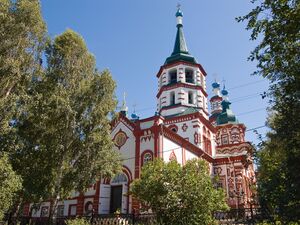
Irkutsk[48] is a point of interest for tourists with its numerous museums and old architecture. The Taltsy Museum (روسية: Тальцы), located on the Angara 47 كيلومتر (29 mi) South of Irkutsk, is an open-air museum of Siberian traditional architecture. Numerous old wooden buildings from villages in the Angara valley, which have been flooded after the construction of the Bratsk Dam and Ust-Ilimsk Dam, have been transported to the museum and reassembled there. One of the centerpieces of the collection is a partial recreation of the 17th-century ostrog (fortress) of Ilimsk, which consists of the original Spasskaya Tower and the Church of Our Lady of Kazan transported from the flooded ostrog in the mid-1970s, to which an exact modern copy of another tower of the ostrog and the Southern wall of the fortress were added in the early 2000s.[49]
The Botanic Garden of the Irkutsk State University known as the "Irkutsk Botanic Garden" is the only botanic garden as a living museum in Irkutsk Oblast and Baikalian Siberia. Its mission is "to protect and enrich the flora of the Lake Baikal area and the world for people through public education, collection, propagation, research, and conservation of plants". The garden is mainly an educational and scientific tool for the Irkutsk State University and maintains the largest plant collection of living plants in Eastern Siberia (more than 5,000 plant taxa), a herbarium, and a seed bank. It occupies 27 هكتار (67 acre) within Irkutsk city, 70 km (43 mi) West of Lake Baikal. It has a federal status of especially protected land and a nature memorial of Irkutsk.[بحاجة لمصدر]
Theaters
Irkutsk is also home to several theaters, including the Okhlopkov Drama Theater, one of Russia's oldest.[50]
المواصلات
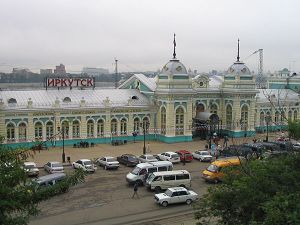
المدن الشقيقة
Irkutsk has the following sister/twin city relationships: [51]
 أولان باتور، عاصمة منغوليا المجاورة.
أولان باتور، عاصمة منغوليا المجاورة. شنيانگ، الصين
شنيانگ، الصين كانازاوا، اليابان
كانازاوا، اليابان يوجين، أوريگون، U.S.A.
يوجين، أوريگون، U.S.A. نوڤي صاد، صربيا
نوڤي صاد، صربيا پفورتسهايم، ألمانيا
پفورتسهايم، ألمانيا Évian-les-Bains، فرنسا
Évian-les-Bains، فرنسا Strömsund، السويد
Strömsund، السويد Pordenone، إيطاليا
Pordenone، إيطاليا گرينوبل، فرنسا
گرينوبل، فرنسا ديجون، فرنسا
ديجون، فرنسا
أشخاص بارزون
- Nikolai Polevoy (1796–1846), editor, writer, translator and historian
- Innocent of Alaska (1797-1879), archbishop, linguist, architect, missionary
- Vladimir Kornilov (1806–1854), naval officer who took part in the Crimean War
- Alexei Pavlovich Fedchenko (1844–1873), naturalist and explorer
- Vladimir Shevyakov (1859–1930), Russian biologist who died in Irkutsk
- Nikolay Vtorov (1866–1918), industrialist
- Alexander Kolchak (1874–1920) Russian Civil War leader, executed at Irkutsk
- Nikolay Okhlopkov (1900–1967), Soviet actor and theatre director
- Mikhail Romm (1901–1971), Soviet film director
- Nikolay Kamov (1902–1973), leading constructor of the Soviet-Russian Kamov helicopter design bureau
- Mikhail Mil (1909–1970), Soviet aerospace engineer
- Konstantin Vyrupayev (1930–2012), Soviet wrestler and Olympic Champion
- Boris Volynov (born 1934), Soviet cosmonaut
- Alexander Vampilov (1937–1972), Soviet playwright
- Rudolf Nureyev (1938–1993), Soviet ballet and contemporary dancer and choreographer
- Olga Buyanova (born 1954), Honored Master of Sports coach in Rhythmic gymnastics of the USSR and Russia
- Oleksandr Shlapak (born 1960), Ukrainian politician, bureaucrat, and former Minister of Finance of Ukraine
- Anatoli Ivanishin (born 1969), cosmonaut
- Oxana Kostina (1972–1993), Soviet individual rhythmic gymnast
- Aleksandr Averbukh (born 1974), Israeli Olympic athlete who competed in the pole vault
- Denis Matsuev (born 1975), classical pianist
- Maria Bruntseva (born 1980), volleyball player
- Nina Kraviz (born 1982), DJ, musician, producer
- Olga Zhitova (born 1983), volleyball player
- Olga Kurban (born 1987), heptathlete
- Alexey Negodaylo (born 1989), bobsledder
- Angelina Zhuk-Krasnova (born 1991), athlete specializing in the pole vault
- Darya Dmitriyeva (born 1993), Russian rhythmic gymnast
- Nazí Paikidze (born 1993), Georgian-American chess player
- Ekaterina Vedeneeva (born 1994), Russian-Slovenian rhythmic gymnast
صور من إركوتسك
A Decembrist house, with distinctive hand-carved trim
المصادر
الهامش
- ^ أ ب ت Charter of Irkutsk Oblast
- ^ أ ب ت ث ج Law #49-OZ
- ^ أ ب Lantzeff, George V., and Richard A. Pierce (1973). Eastward to Empire: Exploration and Conquest on the Russian Open Frontier, to 1750. Montreal: McGill-Queen's U.P.
{{cite book}}: CS1 maint: multiple names: authors list (link) - ^ أ ب "Мэр – Официальный портал города Иркутска". Retrieved December 5, 2015.
- ^ "Федеральная служба государственной статистики Российской Федерации – База данных показателей муниципальных образований". Retrieved March 17, 2016.
- ^ أ ب Russian Federal State Statistics Service (2011). "Всероссийская перепись населения 2010 года. Том 1". Всероссийская перепись населения 2010 года (2010 All-Russia Population Census) (in Russian). Federal State Statistics Service. Retrieved June 29, 2012.
{{cite web}}: Invalid|ref=harv(help); Unknown parameter|trans_title=ignored (|trans-title=suggested) (help)CS1 maint: unrecognized language (link) - ^ أ ب ت Law #88-oz
- ^ Law #94-oz
- ^ "Об исчислении времени". Официальный интернет-портал правовой информации (in Russian). 3 June 2011. Retrieved 19 January 2019.
{{cite web}}: CS1 maint: unrecognized language (link) - ^ Почта России. Информационно-вычислительный центр ОАСУ РПО. (Russian Post). Поиск объектов почтовой связи (Postal Objects Search) (in روسية)
- ^ "International Calling Codes – Pg2". The-acr.com. Retrieved 2013-03-26.
- ^ أ ب Федеральная служба государственной статистики (Federal State Statistics Service) (2004-05-21). "Численность населения России, субъектов Российской Федерации в составе федеральных округов, районов, городских поселений, сельских населённых пунктов – районных центров и сельских населённых пунктов с населением 3 тысячи и более человек[[Category:Articles containing روسية-language text]] (Population of Russia, its federal districts, federal subjects, districts, urban localities, rural localities—administrative centers, and rural localities with population of over 3,000)". Всероссийская перепись населения 2002 года (All-Russia Population Census of 2002) (in Russian). Federal State Statistics Service. Retrieved 2008-07-25.
{{cite web}}: URL–wikilink conflict (help)CS1 maint: unrecognized language (link) - ^ أ ب "Всесоюзная перепись населения 1989 г. Численность наличного населения союзных и автономных республик, автономных областей и округов, краёв, областей, районов, городских поселений и сёл-райцентров.[[Category:Articles containing روسية-language text]] (All Union Population Census of 1989. Present population of union and autonomous republics, autonomous oblasts and okrugs, krais, oblasts, districts, urban settlements, and villages serving as district administrative centers.)". Всесоюзная перепись населения 1989 года (All-Union Population Census of 1989) (in Russian). Demoscope Weekly (website of the Institute of Demographics of the State University—Higher School of Economics. 1989. Retrieved 2007-12-13.
{{cite web}}: Italic or bold markup not allowed in:|publisher=(help); URL–wikilink conflict (help)CS1 maint: unrecognized language (link) - ^ Dameshek (2002), p. 16
- ^ Иркутский острог, кремль и крепость – три названия, одна легенда
- ^ Как застраивали Иркутск
- ^ أ ب ت Иркутский острог. Возникновение и основные этапы развития города Иркутска
- ^ Gentes, Andrew A. (2003). "Siberian Exile and the 1863 Polish Insurrectionists According to Russian Sources". Jahrbücher für Geschichte Osteuropas. 51 (2): 197–217. ISSN 0021-4019.
- ^ "Isu - About Irkutsk". официальный сайт ФГБОУ ВО «Иркутский государственный университет» (in الإنجليزية). Retrieved 2023-11-06.
- ^ "Collections from Siberia and the Russian Far East | Digital Collections from Russia | Articles and Essays | Meeting of Frontiers | Digital Collections | Library of Congress". Library of Congress, Washington, D.C. 20540 USA. Retrieved 2023-11-06.
- ^ "160-ЛЕТИЕ ЯКУТСКО-АЯНСКОГО ТРАКТА". Archived from the original on January 27, 2012. Retrieved December 1, 2020.
- ^ أ ب ت ث One or more of the preceding sentences incorporates text from a publication now in the public domain: Chisholm, Hugh, ed. (1911). . دائرة المعارف البريطانية. Vol. 14 (eleventh ed.). Cambridge University Press. p. 796.
{{cite encyclopedia}}: Cite has empty unknown parameter:|coauthors=(help) - ^ Kennan, George (1891). Siberia and the Exile System. London: James R. Osgood, McIlvaine & Co. pp. 1–2.
- ^ Nechepurenko, Ivan (19 December 2016). "In Russia, Dozens Dies After Drinking Alcohol Substitute". The New York Times. Retrieved 19 December 2016.
- ^ "Russia bath lotion poisoning: Putin orders crackdown as death toll rises". BBC. 21 December 2016. Retrieved 21 December 2016.
- ^ Sarah Rainsford (29 December 2018). "Putin's Russia: Icy Siberia reveals cracks in society". BBC.com. Retrieved 30 December 2018.
- ^ "Russian Officers Assault Two Married Couples". jw.org. 10 October 2021. Retrieved 10 October 2021.
- ^ Frazier, Ian (2009-08-03). "Travels in Siberia—II". The New Yorker (in الإنجليزية الأمريكية). ISSN 0028-792X. Retrieved 2024-01-07.
- ^ "О ПРЕДЫСТОРИИ ИРКУТСКОГО ОСТОРГА". // pribaikal.ru. Archived from the original on 2013-11-10. Retrieved 2011-11-06.
- ^ [Дамешек Л. М. и др. Иркутск в панораме веков: очерки истории города / Под ред. Л. М. Дамешек. — И.: Восточно-Сибирская издательская компания, 2002]
- ^ Дамешек Л. М. и др. Иркутск в панораме веков: очерки истории города / Под ред. Л. М. Дамешек. — И.: Восточно-Сибирская издательская компания, 2002.
- ^ "Исторический центр Иркутска. Подробная информация: расписание, фото, адрес и т. д. на официальном сайте Культура.РФ".
- ^ ИСТОРИЧЕСКИЙ ЦЕНТР ИРКУТСКА
- ^ "Pogoda.ru.net- Climate Data for Irkutsk 1981–2010" (in Russian). Weather and Climate (Погода и климат). Retrieved November 30, 2015.
{{cite web}}: CS1 maint: unrecognized language (link) - ^ "Irkutsk Climate Normals 1961–1990". National Oceanic and Atmospheric Administration. Retrieved November 30, 2015.
- ^ "Irkutsk Hydroelectric Power Station History". Irkutskenergo. Archived from the original on March 25, 2013. Retrieved September 7, 2010.
- ^ "Irkutsk Aviation Industrial Association - Russian Defense Industry". Federation of American Scientists. Retrieved 27 September 2023.
- ^ "Russian Aircraft Industry Seeks Revival Through Merger." The New York Times. February 22, 2006
- ^ "Страница не найдена". Rusal.ru. Archived from the original on فبراير 22, 2012. Retrieved مارس 26, 2013.
- ^ "IGTRK – Irkutsk branch of the State Television and Radio Broadcast Company". Irkutsk.rfn.ru. Archived from the original on April 17, 2013. Retrieved February 7, 2014.
- ^ "AS Baikal TV". AS Baikal TV. Archived from the original on March 24, 2015. Retrieved February 7, 2014.
- ^ "TV Company AIST". Aisttv.ru. Archived from the original on March 1, 2014. Retrieved February 7, 2014.
- ^ "gorodtv.ru. Domain is, probably, for sale". gorodtv.ru. Retrieved December 11, 2018.
- ^ "VSP Newspaper Agency". Vsp.ru. Retrieved February 7, 2014.
- ^ Live webcam in Irkutsk Archived أبريل 1, 2006 at the Wayback Machine
- ^ "Аналитическая служба". Petropavlovsk.net. Archived from the original on سبتمبر 14, 2010. Retrieved فبراير 7, 2014.
- ^ Michael Strogoff by Jules Verne, Charles Scribner's and Sons, 1927
- ^ "Irkutsk – Lonely Planet Travel and Information Guide". Lonelyplanet.com. Retrieved 2014-02-07.
- ^ В «Тальцах» завершается реконструкция южной стены Илимского острога Archived فبراير 14, 2009 at the Wayback Machine (Re-creation of the southern wall of the Ilimsk ostrog in the Taltsy Museum is approaching its completion) (in روسية)
- ^ "Irkutsk: Libertine Legacy by the Lakeside | Beyond Moscow". The Moscow Times. Retrieved 2013-03-26.
- ^ Irkutsk sister cities
مصادر اضافية
- قالب:German
- Polunina N.M., Korobov S.A., Sutton J.M., Korobova G.W. Her Majesty — Queen of Siberia // Publishers Korobov. — Irkutsk, 2008.
وصلات خارجية
| Irkutsk
]].- Flickr photos tagged irkutsk
- Irkutsk in old and modern photos
- Kyzyl
- Baikal Club (in English) Articles about lake Baikal by different people from all over the world.
- Pages using gadget WikiMiniAtlas
- CS1 errors: unsupported parameter
- Articles with روسية-language sources (ru)
- Articles containing روسية-language text
- CS1 errors: URL–wikilink conflict
- CS1 errors: markup
- مقالات المعرفة المحتوية على معلومات من دائرة المعارف البريطانية طبعة 1911
- Wikipedia articles incorporating text from the 1911 Encyclopædia Britannica
- CS1 الإنجليزية الأمريكية-language sources (en-us)
- Short description is different from Wikidata
- Coordinates on Wikidata
- Pages using infobox settlement with image map1 but not image map
- Pages using Lang-xx templates
- Articles containing Russian Buryat-language text
- Articles containing إنگليزية-language text
- Articles with unsourced statements from January 2024
- Articles with unsourced statements from May 2018
- Articles with unsourced statements from October 2012
- Articles with unsourced statements from November 2023
- Articles with hatnote templates targeting a nonexistent page
- إركوتسك
- أماكن مأهولة تأسست في 1686
- مدن وبلدات في أوبلاست إركوتسك
- محافظة إركوتسك
- Populated lakeshore places in Russia
- قائمة المواقع المقترحة للتراث العالمي
- تأسيسات 1686 في روسيا
- صفحات مع الخرائط




